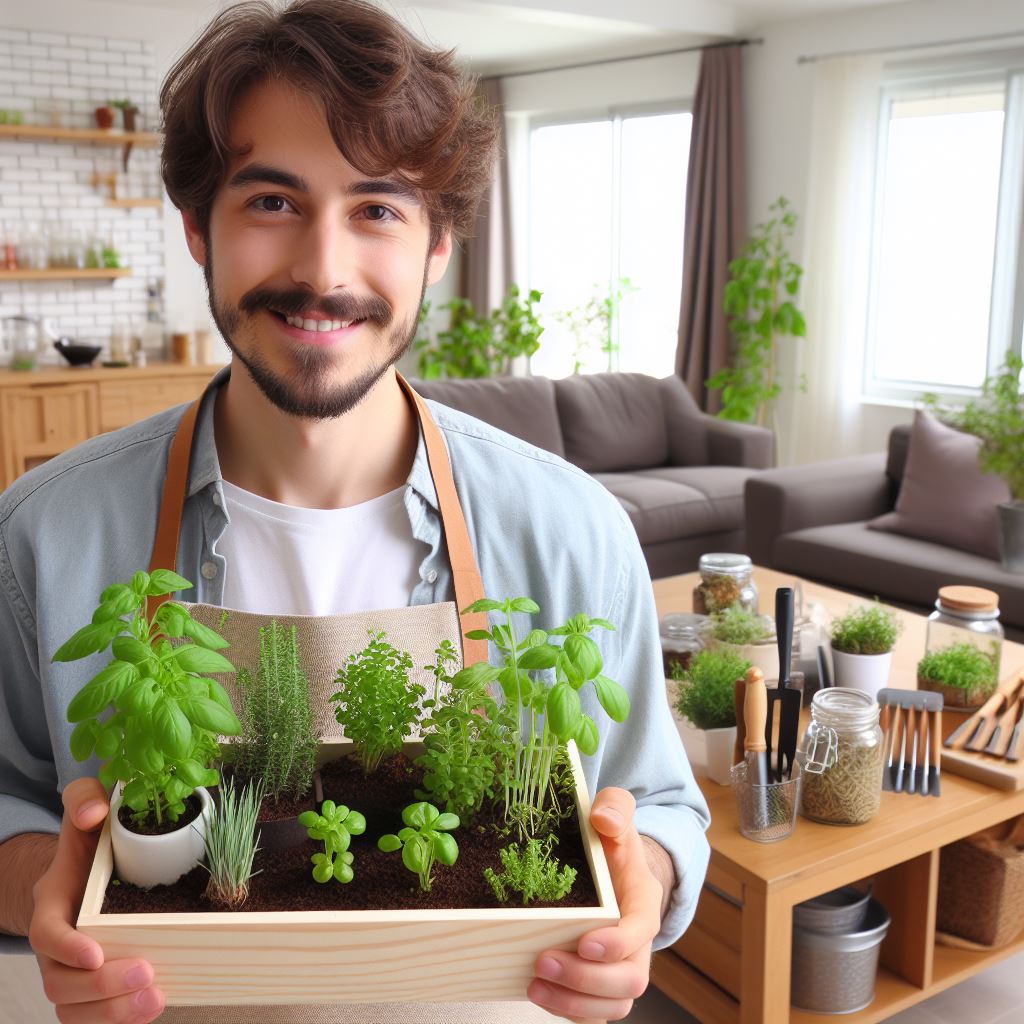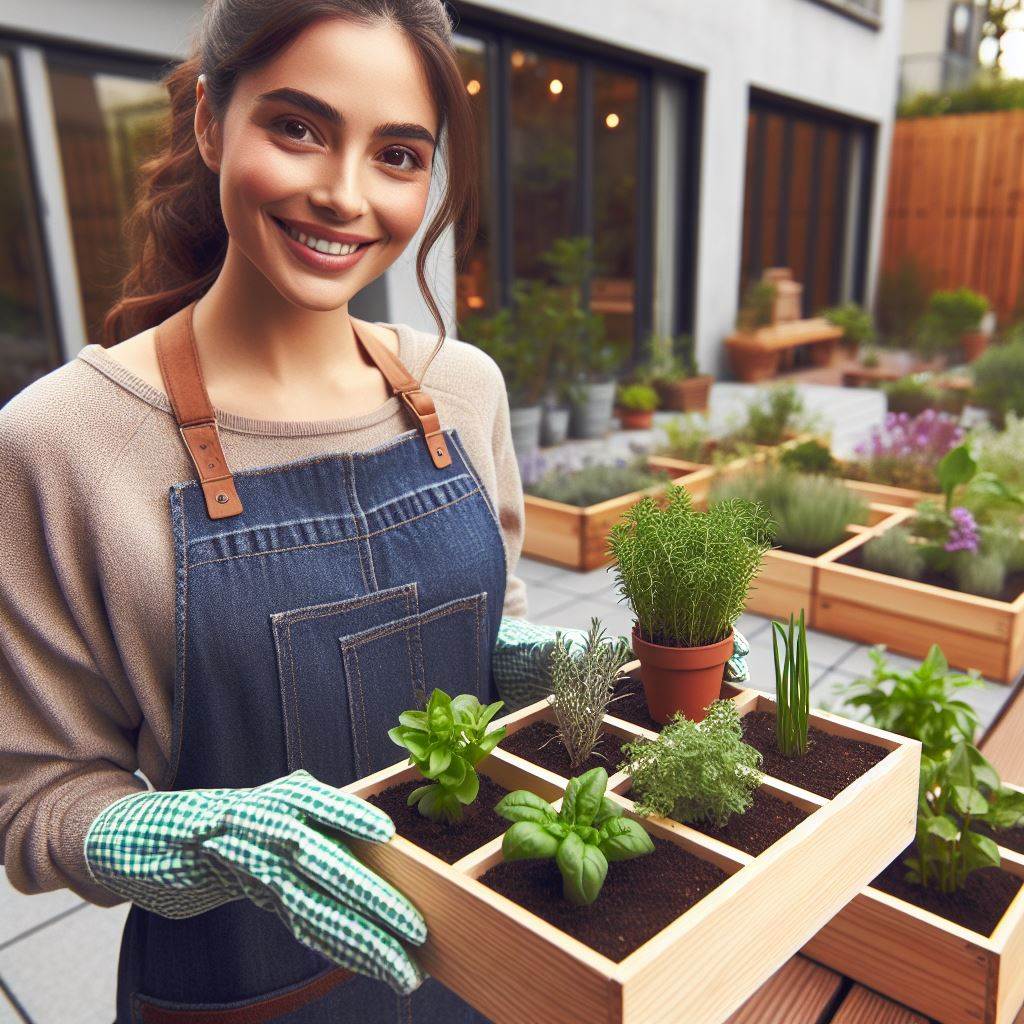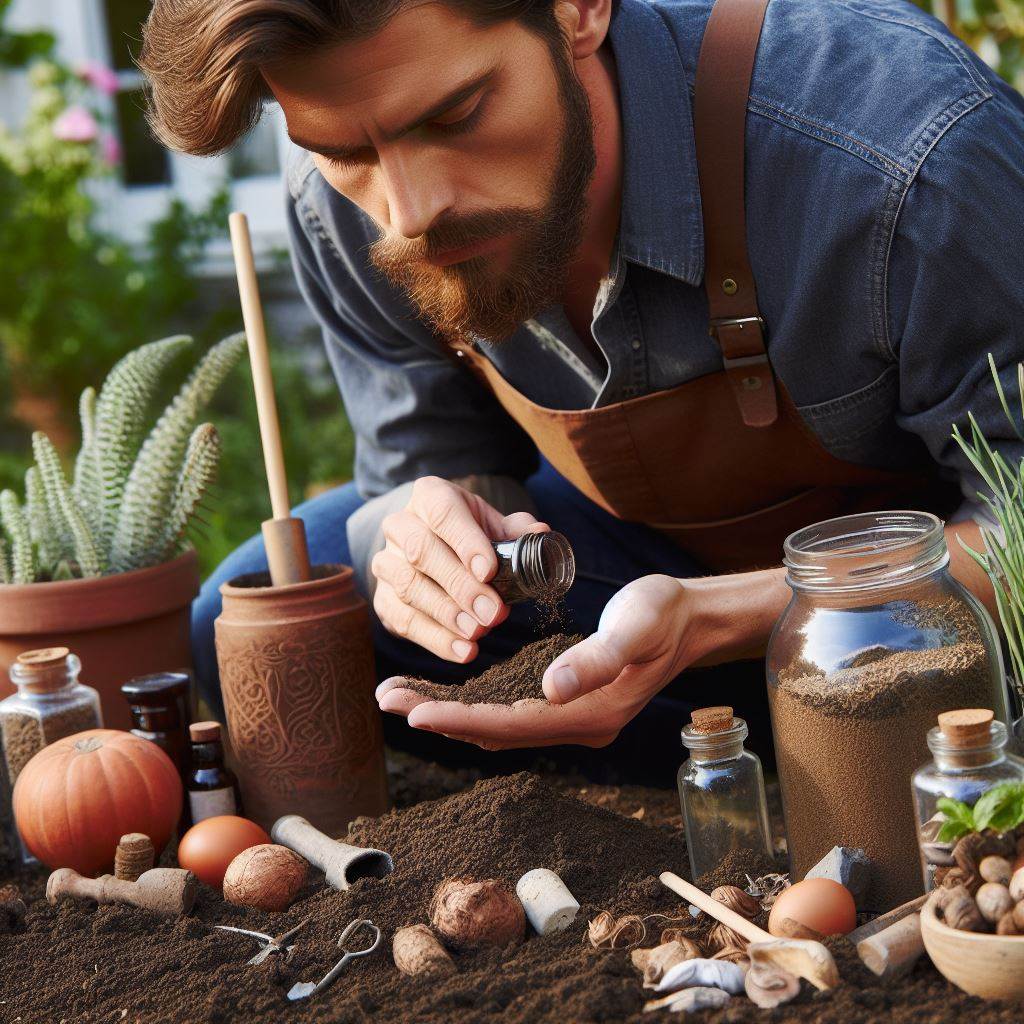Introduction to apartment herb gardening
Apartment herb gardening presents an accessible and rewarding way to introduce freshness into everyday life.
By cultivating herbs indoors, individuals can enjoy a range of benefits, from enhancing culinary experiences to promoting environmental sustainability.
Starting an indoor herb garden is a simple yet fulfilling endeavor.
With the right tools and techniques, even those with limited space can create a flourishing garden within the confines of their apartment.
By growing herbs such as basil, mint, and parsley, individuals can elevate the flavors of their dishes while reducing reliance on store-bought herbs.
The convenience of having fresh herbs readily available cannot be overstated.
Apartment dwellers can enjoy the luxury of snipping herbs directly from their plants whenever needed, adding a burst of flavor and aroma to their cooking.
Additionally, indoor herb gardening allows individuals to reconnect with nature and experience the therapeutic benefits of nurturing living plants.
Basically, apartment herb gardening offers a practical and enjoyable solution for incorporating freshness into urban living.
By embracing this activity, individuals can cultivate a deeper appreciation for nature, enhance their culinary creations, and enjoy the simple pleasure of tending to a garden within the confines of their home.
Getting started with apartment herb gardening
Are you tired of buying expensive herbs from the grocery store?
Why not start your own herb garden in your apartment?
Not only will it save you money, but you’ll also have fresh, delicious herbs at your fingertips whenever you need them.
Starting an apartment herb garden is easier than you think.
Choosing the Right Herbs for Indoor Growing
When selecting herbs for your apartment garden, it’s important to consider which ones thrive indoors.
Transform Your Agribusiness
Unlock your farm's potential with expert advice tailored to your needs. Get actionable steps that drive real results.
Get StartedSome herbs are better suited for outdoor gardens, while others are perfectly content growing in the controlled environment of your apartment.
Here are some popular herbs that do well indoors:
- Basil: This herb is a must-have in any kitchen. Its aromatic leaves are perfect for adding flavor to pasta, salads, and sauces.
- Mint: Mint is known for its refreshing scent and taste. It can be used in cocktails, tea, or as a garnish on desserts.
- Rosemary: This herb has a distinct pine-like fragrance that enhances the flavor of roasted meats and vegetables.
- Thyme: Thyme is a versatile herb that pairs well with poultry, fish, and vegetables. It also adds a unique flavor to soups and stews.
- Parsley: Often used as a garnish, parsley is also packed with vitamins and adds a fresh taste to salads and pasta dishes.
Considerations for Available Space and Lighting
Before starting your apartment herb garden, it’s crucial to assess the available space and lighting in your apartment.
Most herbs require at least six hours of direct sunlight daily, so make sure you have a window that receives adequate sunlight.
If natural light is limited, you can also use artificial grow lights to supplement the plants’ needs.
If space is a concern, consider vertical gardening.
This technique utilizes wall-mounted planters or hanging baskets to maximize your growing area.
You can also use window boxes or window sill planters for convenient access to your herbs.
Selecting Appropriate Containers and Potting Soil
Choosing the right containers and potting soil is essential for the success of your apartment herb garden.
Here are some tips to help you get started:
- Containers: Use pots or containers with drainage holes to prevent waterlogging. This allows excess water to escape and prevents root rot.
- Size: The container should be proportionate to the herb’s mature size. Most herbs prefer slightly smaller pots, as they don’t require much space for their root systems.
- Potting Soil: Use a high-quality, well-draining potting mix specifically designed for container gardening. Avoid using garden soil, as it may contain pests and diseases.
Now that you have a basic understanding of apartment herb gardening, it’s time to get your hands dirty!
Choose your favorite herbs, find a sunny spot in your apartment, and start growing your own fresh and flavorful herbs today.
With just a little bit of effort, you’ll have a bountiful herb garden right at your fingertips.
Happy gardening!
Read: Compact Herb Gardening: A Step-by-Step Guide
Setting up your apartment herb garden
One of the most rewarding and convenient ways to have fresh herbs at hand is by setting up an apartment herb garden.
Whether you have a small balcony, a sunny windowsill, or even just some wall space, you can create a thriving herb garden right in your own home.
- Finding a suitable location in your apartment is crucial for the success of your herb garden.
- Look for areas that receive at least six hours of sunlight a day, such as south-facing windows or balconies.
- Choose a spot that is easily accessible for watering and harvesting your herbs.
Arranging herbs based on their sun and water requirements
- Group herbs with similar sun and water requirements together to make care easier.
- Some herbs, like basil and rosemary, require full sun, while others, like mint and parsley, can tolerate partial shade.
- Water requirements vary among herbs, so consider grouping them based on their moisture needs as well.
Utilizing vertical space with hanging or wall-mounted planters
- If you have limited floor space, make use of vertical space by hanging or wall-mounting planters.
- There are various hanging options available, from macrame plant hangers to hanging baskets and vertical garden systems.
- Wall-mounted planters can be attached to any free wall space, adding a touch of greenery to your apartment decor.
Having an apartment herb garden not only provides you with easy access to fresh flavors for your meals but also adds beauty and freshness to your living space.
With a little planning and creativity, you can enjoy the pleasures of gardening even in a small apartment.
Read: Urban Herb Farming: Tips for Your Window Ledge
Caring for your apartment herb garden
Caring for your apartment herb garden is essential to ensure the freshness and availability of herbs right at your fingertips.
Regular watering and monitoring moisture levels
- Water your herbs regularly, ensuring that the soil is moist but not waterlogged.
- Check the moisture levels of the soil regularly and adjust your watering schedule accordingly.
- Avoid overwatering as it can lead to root rot and other problems.
- Consider using self-watering pots or a drip irrigation system to maintain consistent moisture levels.
Providing adequate sunlight or artificial light sources
- Place your apartment herb garden near a window that receives ample sunlight.
- If sunlight is limited, consider using artificial light sources such as fluorescent or LED lights.
- Ensure that the herbs receive at least 6-8 hours of direct or indirect sunlight daily.
- Rotate the pots occasionally to allow all sides of the plants to receive sufficient light.
Maintaining proper temperature and humidity
- Most herbs thrive in temperatures between 60-75°F (15-24°C).
- Avoid exposing your herbs to extreme temperature fluctuations or drafts.
- Monitor the humidity levels in your apartment, especially during dry seasons. Consider using a humidifier if needed.
- Ensure proper air circulation to prevent mold or fungal growth.
With proper care, your apartment herb garden will flourish and provide you with fresh herbs throughout the year.
Remember to harvest the herbs regularly to promote growth and enjoy the flavors they add to your cooking.
Read: Herb Gardening 101: Perfect for Tiny Yards
Showcase Your Farming Business
Publish your professional farming services profile on our blog for a one-time fee of $200 and reach a dedicated audience of farmers and agribusiness owners.
Publish Your Profile
Learn More: Watering Wisely: Seasonal Strategies
Harvesting and Using Fresh Herbs
One of the joys of having an apartment herb garden is the ability to harvest fresh herbs whenever you need them.
Here are some tips on how to harvest and use your herbs:
- Harvest your herbs in the morning, after the dew has dried but before the sun is too high.
- Use sharp scissors or a small knife to cut off the top 1/3 of the herb stems.
- Avoid cutting more than 1/3 of the plant at a time to ensure continuous growth.
- Wash the harvested herbs gently in cold water to remove any dirt or pests.
- Pat the herbs dry with a clean towel or use a salad spinner to remove excess water.
- Chop the herbs finely for immediate use or leave them whole if you plan to store them.
- You can use fresh herbs as a garnish, steep them in hot water for herbal teas, or incorporate them into your cooking.
- Add fresh herbs to salads, pasta dishes, soups, stir-fries, marinades, and dressings for a burst of flavor.
- Experiment with different combinations of herbs to find your favorite flavor profiles.
- If you have more herbs than you can use, share them with friends, family, or neighbors.
Preserving and Storing Your Harvest
If you have a surplus of fresh herbs from your garden, it’s important to preserve them properly to prolong their freshness.
Here are some techniques for storing herbs:
- Hang your herbs upside down in a cool, dry place to air dry. This method works best for herbs with woody stems like rosemary, thyme, and oregano.
- Alternatively, you can dry herbs by laying them on a clean, dry surface or using a food dehydrator.
- Once dried, store herbs in airtight containers away from direct sunlight and heat.
- You can also freeze herbs by chopping them and placing them in ice cube trays filled with water or olive oil.
- Another method is to make herb-infused oils or vinegars by steeping herbs in a high-quality oil or vinegar for a few weeks.
- Label your preserved herbs with the name and date to keep track of their freshness.
- When using dried herbs in recipes, remember to reduce the amount as they are more concentrated in flavor compared to fresh herbs.
Creative Ways to Incorporate Fresh Herbs into Your Meals
Don’t limit yourself to using fresh herbs as mere garnishes.
Here are some creative ideas to incorporate them into your meals:
- Make homemade herb butter by mixing softened butter with finely chopped herbs. Spread it on bread, melt it on grilled meat or vegetables, or use it to sauté.
- Create herb-infused syrups or simple syrups by boiling herbs with sugar and water. Use these syrups in cocktails, lemonades, or to drizzle over desserts.
- Blend fresh herbs with olive oil, garlic, nuts, and cheese to make various pesto sauces. Serve them with pasta, as a spread, or as a dip.
- Add a handful of fresh herbs to your favorite smoothie or juice for an extra boost of freshness and nutrients.
- Make herb-infused ice cubes by freezing herbs in water or juice. Add these flavored ice cubes to your beverages or use them in cooking.
- Create herb-infused salts or sugars by blending dried herbs with these ingredients. Use them as seasoning or to rim cocktail glasses.
- Experiment with herb-infused desserts like lavender-infused crème brûlée, rosemary shortbread cookies, or basil-infused lemon sorbet.
- Use fresh herbs as a topping for pizzas, sandwiches, tacos, or bruschetta.
- Mix chopped herbs into your favorite salad dressings for an added burst of flavor.
With these tips and ideas, you can enjoy the freshness and aroma of herbs right in your apartment, elevating your meals to a whole new level!
Read: Small Garden, Big Flavor: Growing Herbs Easily
Troubleshooting common issues in apartment herb gardening
- Yellowing leaves: Check if the plant is receiving enough sunlight and adjust watering frequency.
- Poor growth: Evaluate the soil quality and consider using organic fertilizers to enhance nutrition.
- Wilting plants: Ensure proper drainage by using well-draining containers and avoid overwatering.
- Leggy plants: Provide adequate light by placing the herbs near a south-facing window.
- Root rot: Prevent waterlogging by allowing the soil to dry out between waterings and use a well-draining potting mix.
- Stunted growth: Adjust the watering schedule and avoid using excessive amounts of fertilizer.
Pest control methods for indoor herb plants
- Aphids: Spray a mixture of water and mild soap on the affected plant parts to deter them.
- Spider mites: Regularly mist the leaves to increase humidity and wipe them off with a damp cloth.
- Whiteflies: Use sticky traps near the infected herbs to catch and control their population.
- Fungus gnats: Let the plants dry out between waterings and avoid overwatering to discourage these pests.
- Mealybugs: Remove them manually with a cotton swab dipped in alcohol or use insecticidal soap.
- Scale insects: Scrape them off with a toothbrush or cotton swab, or use horticultural oil as an alternative.
Dealing with diseases and common plant problems
- Powdery mildew: Remove infected leaves, improve air circulation, and avoid overhead watering.
- Root rot: Improve drainage, avoid overwatering, and consider using a fungicide if the problem persists.
- Leaf spots: Remove infected leaves, improve air circulation, and spray with a copper-based fungicide.
- Wilting: Check soil moisture regularly and adjust watering accordingly. Trim damaged roots if necessary.
- Bolting: Harvest leaves regularly, provide sufficient light, and maintain optimal room temperature.
- Yellowing leaves: Assess water and light conditions, adjust fertilization, and monitor for pests or diseases.
Addressing issues related to over or under watering
- Overwatering: Allow the soil to dry out slightly between waterings and use well-draining containers.
- Underwatering: Check soil moisture regularly and water thoroughly when the top inch feels dry.
- Root rot: Avoid waterlogging by ensuring proper drainage and using a suitable potting mix.
- Wilting: Assess the moisture level of the soil and adjust watering accordingly. Trim damaged roots if necessary.
- Yellowing leaves: Evaluate the watering frequency and adjust accordingly, ensuring not to over or underwater.
- Fungal diseases: Overwatering can promote disease development, so maintain proper watering practices to prevent them.
Uncover the Details: Seasonal Planting Guide for Compact Spaces
Conclusion
Apartment herb gardening offers numerous benefits for individuals living in small spaces.
Firstly, it provides the opportunity to have fresh, organic herbs readily available at any time.
Moreover, it allows individuals to engage in a rewarding and therapeutic activity, fostering a sense of accomplishment.
Additionally, apartment herb gardening promotes sustainability by reducing the need for store-bought herbs and decreasing food waste.
Furthermore, it enhances the flavor and aroma of home-cooked meals, elevating the dining experience for both the cook and guests.
Apartment herb gardening is a cost-effective solution, saving money that would otherwise be spent on buying herbs regularly.
With these remarkable benefits in mind, I encourage all readers to start their own indoor herb garden.
Even with limited space, one can utilize windowsills, balconies, or vertical gardening techniques to grow herbs.
Remember, every effort made towards nurturing your herb garden will pay off in flavor, nutrition, and overall well-being.
So, why not embark on this delightful journey of cultivating your own apartment herb garden today?
Enjoy the convenience, joy, and fulfillment that come with having fresh herbs readily available at home.




